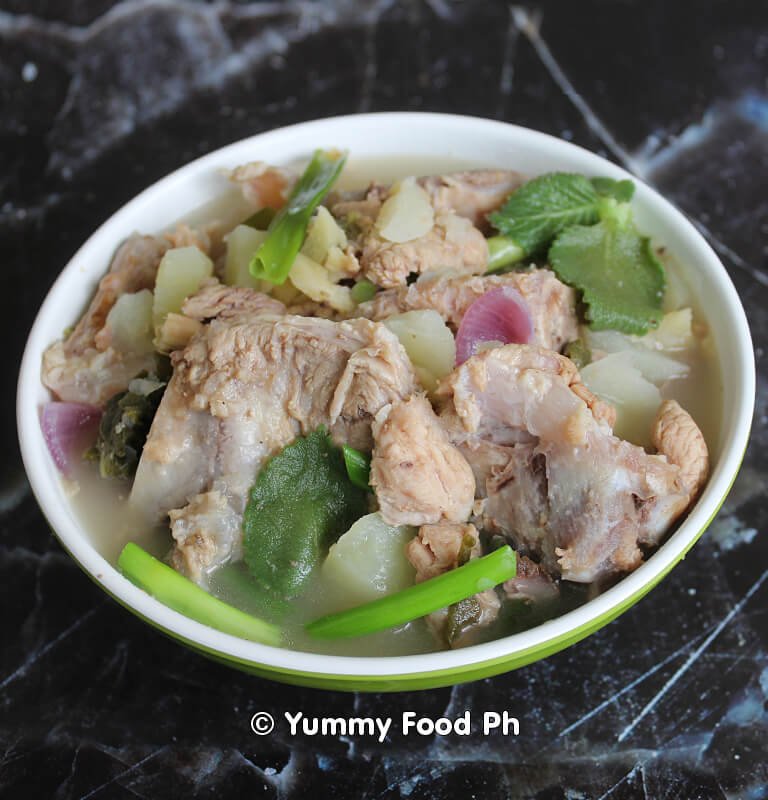Filipino Pork Dinuguan Recipe
Pork Dinuguan recipe or Dinuguang Baboy is a dish made of pork cooked with pork blood, which gives it its dark color. Traditionally, Filipino savory stews called dinuguan use pork offal, typically the lungs, kidneys, intestines, ears, heart, and snout. It is cooked and simmered in a thick, savory, dark pig’s blood gravy. For this recipe, instead of using pork offal cuts, we only used pork kasim. The meat is sliced into bite-size pieces, sauteed in spices, and cooked in pig’s blood, vinegar, certain seasonings, and a long green chili called the siling haba. This Filipino pork blood stew dish has many local names based on its region and the way it is prepared. In Cebuano, it is called dugo dugo, sinugaok in Batangas, dinardaraan in the Ilocos area, and many more.
Share and enjoy! Have fun cooking! To find more recipes, feel free to check out our recipe archive. We appreciate you stopping by.
Visit us on YouTube: Yummy Food PH

Pork Dinuguan Recipe or Dinuguang Baboy
Description
Pork Dinuguan recipe or Dinuguang Baboy is a dish made of pork cooked with pork blood, which gives it its dark color. Traditionally, Filipino savory stews called dinuguan use pork offal, typically the lungs, kidneys, intestines, ears, heart, and snout. It is cooked and simmered in a thick, savory, dark pig's blood gravy. For this recipe, instead of using pork offal cuts, we only used pork kasim. The meat is sliced into bite-size pieces, sauteed in spices, and cooked in pig's blood, vinegar, certain seasonings, and a long green chili called the siling haba. This Filipino pork blood stew dish has many local names based on its region and the way it is prepared. In Cebuano, it is called dugo dugo, sinugaok in Batangas, dinardaraan in the Ilocos area, and many more.
Ingredients
Instructions
Preparation:
Wash and clean the pork, then slice it into bite-size pieces.
Peel and chop the onions and garlic. Seeded the tomato and chopped it.
Cooking:
In a pan, heat 2 tablespoons of cooking oil. Saute the onion until it softens; add the garlic and saute until light brown and aromatic. Then add the tomato slice, keep sauteing, and gently mash the tomato until it gets soft.
Add the pork and cook for a few minutes, stirring. Then add the patis (fish sauce). Keep cooking while stirring occasionally for 3 minutes or until the color changes to light brown and the fats start rendering.
Add 1 ½ cup water and bring the liquid to a boil. Then add the vinegar and salt. Do not stir. Cover the pan and cook for 8 to 10 minutes, or until the meat gets tender.
Note: Add water if necessary until the meat gets tender. The amount of water used depends on the quality of the meat.Check, and once the meat is tender enough, add sugar and green chili and stir. Add the pig blood and cook. Keep stirring for about 5 minutes.
Add seasoning granules to taste if desired, and season with freshly ground black pepper to taste. Taste it and adjust as necessary. Lower the heat and simmer for about 2 minutes or until the sauce thickens to the desired consistency.
Turn the heat off and transfer to a serving bowl.
It's best to serve it with sinangag and puto. Enjoy!
Nutrition Facts
Servings 8
- Amount Per Serving
- Calories 1076kcal
- % Daily Value *
- Total Fat 105.4g163%
- Saturated Fat 39.3g197%
- Cholesterol 139mg47%
- Sodium 1398mg59%
- Potassium 197mg6%
- Total Carbohydrate 7.3g3%
- Dietary Fiber 1g4%
- Sugars 3.5g
- Protein 21.5g43%
- Calcium 21 mg
- Iron 2 mg
* Percent Daily Values are based on a 2,000 calorie diet. Your daily value may be higher or lower depending on your calorie needs.





